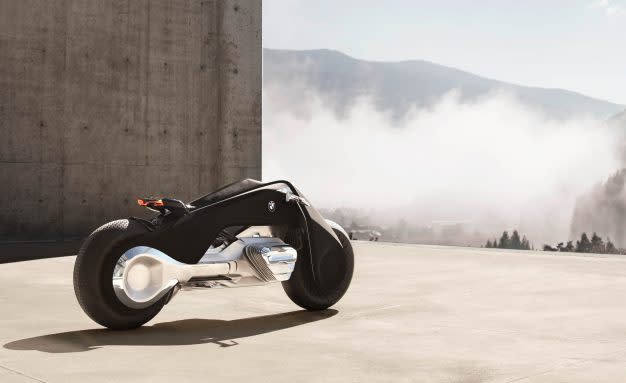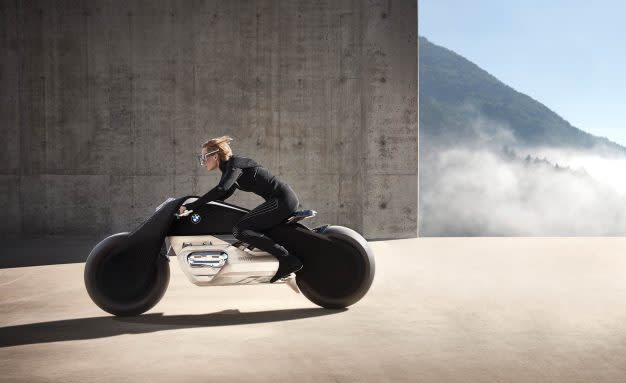BMW's Wild New Self-Balancing Motorcycle Concept Wouldn't Require a Helmet

If BMW is right, motorcycles in the distant future will look like the lovechild of a Terminator T1000 and a Rokon Trail-Breaker. Or, maybe not. The newly unveiled Vision Next 100 concept from BMW's Motorrad motorcycle department isn't meant to be a prediction so much as a daydream about what might be coming in the generations after the next generation of products. Think composite elastic frames that eliminate the suspension and steering fork, self-balancing gyroscopes, augmented-reality visors, and enough artificial intelligence in the safety systems that helmets won't even be necessary. As we said, a daydream.
One of a handful of automakers that also produces motorcycles, BMW has incorporated its Motorrad division into a grand styling exercise called BMW Vision Next 100, a traveling roadshow headed to cities and auto shows and open to the public, in which all the Munich automaker's brands present concepts that push the boundaries on styling and technology for the next century of motoring. The BMW, Rolls-Royce, and Mini concepts were previously shown in March, May, and June. Motorrad closed the loop this week in Santa Monica, California with this butch looking two-wheeler dubbed "The Great Escape" that has both highly futuristic and nostalgic design elements meant to be an exciting wind-in-your-face counterpoint to the wave of automated transport pods that are assuredly coming.

To make it look unmistakably like a BMW, the creation team led by Motorrad design chief Edgar Heinrich incorporates the classic black triangular frame from BMW bikes of the 1930s, as well as the white pinstriping and horizontally opposed boxer jugs long identified with BMW. In this case, however, the jugs, which breathe in and out like bellows as the bike rolls along, aren't engine parts so much as cooling towers for some indeterminate zero-emissions powerplant.
The rider wears a "flexible bionic structure" of supportive garments that move with him or her to reduce fatigue and assist in operating the machine. There are no gauges; all relevant data is projected onto a multilayer three-dimensional visor that changes depending on where the rider looks. Tilt down and you get the bike gauges or a scrolling map; look up and you get a cleaner view of the road ahead with computer assistance (if you desire) telling you where to aim the bike and what-or who-might be around the next bend thanks to the future's interconnected road network.
Heinrich's team asked current bikers what they want, and the answer was riding as in the old days before clunky helmets and heavy safety gear. People want bike clothes that are as comfortable as their everyday clothes, Heinrich says, so BMW envisioned a bike so smart that its rider can get away with nothing more than a thin (albeit bionic) jumpsuit, the onboard self-balancing gyros keeping it upright when necessary and the hyper intelligence of its safety systems keeping it out of conflict with other cars and the terrain.

Another right-now issue the concept addresses is motorcycle packaging, which is increasingly more complicated thanks to emissions and safety systems and their related black boxes. The so-called "Flex Frame" is meant to greatly simplify the structure by imagining a composite mono-frame that is both rigid and flexible where it needs to be. Heinrich called it something they can imagine now, even if they don't have the technology to make it yet.
BMW sold almost 137,000 bikes in 2015, accounting for 15 percent of the global market, and projects growth to 200,000 by 2020 partly because of an aggressive move into two-wheelers that are smaller and cheaper. A sub-$5000 family of bikes starting with the G310R and G310GS are on their way, while BMW also took the occasion of its Vision Next 100 launch to show the giant K1600B, a lavishly sculpted sport cruiser with integrated side-bags.
BMW Group Design chief Adrian van Hooydonk says the Vision Next 100 challenge was to come up with out-there ideas without being too out there. Thus, for example, all of the Vision Next 100 vehicles have wheels. "We wanted to think far enough ahead but not so far that it's a cartoon or science fiction."
From: Car and Driver
You Might Also Like
